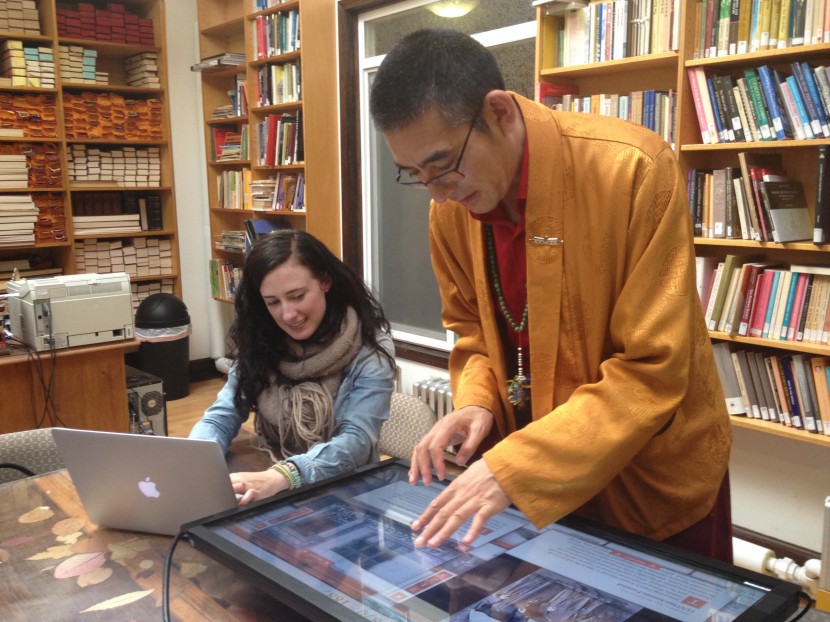Octave 9, the Seattle Symphony’s experimental music venue, gives fresh meaning to the term “multisensory.” With an intimate performance space, cutting edge audio technology, and a library of generative visual themes, Octave 9 engages with audiences on a whole new level. Learn more about what it took to realize Octave 9:
Belle & Wissell worked closely with the Seattle Symphony to craft the Immersive Canvas: a visual accompaniment to live performances. Built to respond to live instrumentation with over 30 visual effects, the Immersive Canvas transforms Octave 9 into an expressive palette of pattern and color.
Octave 9 is a space for experimentation, fusing traditional music performance with new technologies. To further explore the interdisciplinary possibilities, the generative visual effects engine may be customized by visiting artists and Octave 9 staff. Visual themes can be choreographed and switched with the tap of a foot pedal, or timed according to a piece of music.
Belle & Wissell collaborated with a suite of highly-capable project partners to bring Octave 9 to life. LMN Architects evolved the challenging space into one well-suited for experimental performances, while Meyer Sound technologies and Jaffe Holden acoustic engineers provided the equipment and expertise to deliver immersive, incredible sound quality.
Additional project details, photos, and video documentation are available here.
Learn about what drives Belle & Wissell’s work, as the studio’s founder presents at the Society for Experiential Graphic Design (SEGD) Exhibition and Experience Design Conference.
In this 30-minute workshop titled “Expanding the Experience (Through Collaboration)”, Gabe describes what he learned from experiments in collaboration at Born Magazine—and details Born’s impact on Belle & Wissell’s work for SFMOMA and Understory (at Amazon’s headquarters in Seattle).
Watch Gabe Kean (Belle & Wissell’s founder and Principal) as he provides a behind-the-scenes look into the studio’s process—presented at the Society for Experiential Graphic Design (SEGD) Conference in Seattle, titled “Approaching the Media-Centric Project.”
In this one-hour workshop and Q+A session, Gabe uses the Space Needle’s SkyPad™ as his primary case study. Further examples include The Frick Orientation Center in Pittsburgh, and the Digital Retail Experiences at Umpqua Bank’s flagship store in San Francisco.
During the development of all Belle & Wissell projects, a critical process step is a period of rigorous usability testing. The name alone reveals its purpose: how intuitive, accessible, and universal will this experience be for its users?
Recently, Belle & Wissell was fortunate enough to conduct usability testing with a friend of the studio, Venerable Tulku Yeshi Rinpoche. He is a resident lama at Sakya Monastery in Seattle. Ven. Tulku Yeshi graciously assisted with a project under development, offering both words of encouragement and insightful observations.
Based on core audience profiles, Belle & Wissell selects a small group to test that best represents each audience segment. The consideration of these future users drives the final design and functionality of each new interface.
Aside from being a highly important component of any project, usability testing allows the design and development teams to pre-visualize their work in action.
We thank Venerable Tulku Yeshi Rinpoche (and all our participants) for your indispensable assistance, comments, and enthusiasm.
Learn more about the Sakya Monastery and Ven. Tulku Yeshi on his Facebook page here.
 Watch Gabe Kean and Thomas Ryun’s presentation at Creative Mornings in Seattle (2012) as they walk through some key projects and provide some insight on the Belle & Wissell process. Includes behind-the-scenes looks at “Nirvana: Taking Punk to the Masses” (exhibit graphic design and interactives), The Clyfford Still Museum Interactive Timeline” (interactive exhibit), “True Evel: The Amazing Story of Evel Knievel” (exhibition and arcade game design), and “Your Face is Puzzling to Me” (streetscape media installation).
Watch Gabe Kean and Thomas Ryun’s presentation at Creative Mornings in Seattle (2012) as they walk through some key projects and provide some insight on the Belle & Wissell process. Includes behind-the-scenes looks at “Nirvana: Taking Punk to the Masses” (exhibit graphic design and interactives), The Clyfford Still Museum Interactive Timeline” (interactive exhibit), “True Evel: The Amazing Story of Evel Knievel” (exhibition and arcade game design), and “Your Face is Puzzling to Me” (streetscape media installation).
Remember back before Chuck E. Cheese? Showbiz Pizza Place was the original family fun spot, with the animatronic performing band…Rock-a-fire Explosion, powered by ’70s technology.
This “show”, or set of pneumatic-driven band members (originally designed and manufactured by Creative Engineering) are being rebuilt and upgraded by Jason Rudolph in West Seattle, currently at a large, vacant retail space (formerly Petco). Jason is looking at new ways to control the band and to create new shows. First step is to rehabilitate the vintage band members.

Under-the-latex, all moving parts are actuated with compressed air-powered cylinders.

This is essentially a communications hub, which handles all of the switching for the pneumatic controls-currently a Tivo is sending the show controls’ timing through a bundle of wires with data that tells the band how to move and when to move, so that it syncs with the music.

Studio design director Gabe Kean featured here:
http://www.commarts.com/insights/embrace-process.html
Hundreds turned out for our opening event on December 13th. We’ve included some photos that captured this memorable occasion… Story Kits available at our Etsy store.













